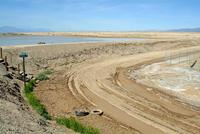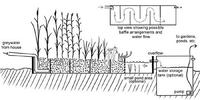-
Furloughs hamper U.S. ability to respond to chemical disasters
Rafael Moure-Eraso, the chairman of the U.S. Chemical Safety Board(CSB) warned that the agency would be unable to respond to major chemical-related disasters if the government shutdown continued. The agency has furloughed more than 90 percent of its workers. The shutdown has delayed other CSB investigations into chemical accidents in California, Utah, Washington, and Texas. Moure-Eraso said that the delays in investigations could threaten public safety as the agency is unable to make recommendations for prevention of similar accidents.
-
-
Research investments, growing markets drive rise in energy patents

Innovation in energy technology is booming, according to a new paper which examines what factors set the pace for energy innovation. The study finds that investments in research and development, as well as in the growth of markets for these products, have helped to spur this dramatic growth in innovation.
-
-
Debate heats up over N.Y.’s Indian Point nuke license renewal
Indian Point nuclear power plant, located twenty-four miles north of New York City, provides 25 percent of the power used in New York City and Westchester County. The plant’s two reactors were built four decades ago, and the plant operator is seeking a 20-year license renewal for them, or they will have to be shut down. Opponents of the license renewal point to the risk inherent in operating aging reactors – and to a recently discovered risk: Indian Point is located near two active seismic areas — the Ramapo Fault Plain and the Peekskill-Stamford line.
-
-
Hitting the road: Redefining infrastructure maintenance
The results of the Remote-Sensing and GIS-enabled Asset Management System, Phase 2 (RS-GAMS2) project, a 2-year, $1.9 million research enterprise, were released in late August. The project promises to revolutionize the way U.S. roads are inventoried, managed, and maintained. Sponsored by grants from the U.S. and Georgia Departments of Transportation, a multi-disciplinary team of researchers has been developing the system for the past two years, using 18,000 miles of Georgia roadways as their laboratory.
-
-
Guardrails made safer with impact-absorbing Mediterranean tapeweed coating
Researchers have developed protective guardrails from residue of Posidonia oceanica,commonly known as Neptune Grass or Mediterranean tapeweed, in order to minimize the risk of injuries on the roads. The waste material is useful for coating the support posts of guard rails on roads so they can absorb and dissipate much of the kinetic energy if a collision occurs, preventing lacerations and amputations in cases in which a human body hits the support post.
-
-
Long-term trend of saltwater intrusion in the Everglades confirmed
Mangroves love salt water, while sawgrass depends on fresh water. Satellite imagery over the southeastern Everglades confirms long-term trends of mangrove expansion and sawgrass habitat loss near the shore. The trend is related to salt water intrusion caused by sea-level rise and water management practices. Changes in water management, such as the implementation of the Comprehensive Everglades Restoration Plan, may help offset the possible effects caused by future salt water intrusion, but restoration may not suffice if sea-level rise accelerates.
-
-
Crumbling infrastructure hobbles U.S. competitiveness

America’s infrastructure has long been denied the investment and attention needed from public and private entities to remain competitive in an ever-growing global economy. U.S. roads, bridges, power plants, airports, utilities, and other critical infrastructure were once the envy of the world. The post-Second World War golden era (that is, golden era as far as investments in infrastructure are concerned) has come to an end, and fewer resources are committed to improving and maintaining the country’s infrastructure.
-
-
Rural California country faces levee dilemma

About 400 homes and rich farmland in District-10 of Marysville, California risk being flooded should the levees protecting the area fail. The levees, stretching over twenty-eight miles, were built in the early 1900s. The area’s low population may be one reason why county officials have neglected making improvements to the levees in District-10. Local opponents of investment in shoring up the levees are worried that if the levees are improved and the area made safer, “It would open the door for more agribusiness type things, but it would also open the door for more subdivisions,” in the words of one of them.
-
-
N.J. coastal wetlands moderated some of Hurricane Sandy’s fury

Monitoring sensors along the New Jersey coast recorded marsh and wetland swelling during Hurricane Sandy. That swelling is an indication of marshes’ ability to absorb some of the storm surge — which, in hard-hit urban areas, had resulted in high water marks up to seven feet during Hurricane Sandy. Resilient, healthy wetlands near coastal areas have a key role in protecting local communities from hurricane-induced storm surges and flooding.
-
-
First ever evidence discovered of a comet striking Earth

The first ever evidence of a comet entering Earth’s atmosphere and exploding, raining down a shock wave of fire which obliterated every life form in its path, has been discovered. The comet entered Earth’s atmosphere above Egypt about twenty-eight million years ago. As it entered the atmosphere, it exploded, heating up the sand beneath it to a temperature of about 2,000 degrees Celsius, and resulting in the formation of a huge amount of yellow silica glass which lies scattered over a 6,000 square kilometer area in the Sahara.
-
-
Reducing urban water leakage
No resource is more fundamental to life and human society than water. Yet, globally, 25 to 30 percent of drinking water is lost every year due to leakages in urban water distribution systems. An EU-funded project is proposing an innovative solution for the automatic detection, sealing, and curing of typical network pipes, without digging up pavements and roads.
-
-
U.S. nation-wide quake early-warning system
The United States is likely to be struck by a major earthquake within the next twenty years. Scientists say that instead of waiting to experience a devastating earthquake and then invest in preventative measures for subsequent earthquakes, the country should be proactive and take action before the event. Investing in a nationwide earthquake warning system will save lives, prevent destruction of key infrastructure, and reduce the size of the economic loss that may result from an earthquake.
-
-
Costly DOE uranium processing facility questioned

The cost of a proposed Department of Energy’s uranium processing facility for nuclear weapons at theY-12 National Security Complex in Oak Ridge, Tennessee has increase nineteen times – from the original estimate of $600 million to $11.6 billion. If these estimates are accurate, the processing facility would entail one the largest investments in the U.S. nuclear weapons infrastructure since the Manhattan Project.
-
-
$5 million NSF grant focuses on nuclear threat inspection
Penn State University has received a 5-year grant from the National Science Foundation (NSF) and DHS for nuclear threat inspection, as part of a team led by the Massachusetts Institute of Technology and including Georgia Tech. The grant will help develop new systems and sensors that will help detect nuclear weapons, special nuclear materials, radiation dispersal devices, and related threats.
-
-
Bolstering water security in a crowded world

With limited water and the increasing number of people depending on it – there will be more than nine billion people on the planet by 2050 — water security is tenuous. Integrated water management plans using “blue,” “green,” and “gray” water, however, can increase water security by allowing agriculture to rise to the challenge of feeding a growing world population while leaving enough water for other uses.
-
More headlines
The long view
Helping Strengthen America’s Critical Infrastructure
Everyday life depends on a robust infrastructure network that provides access to running water, communications technology and electricity, among other basic necessities. The experts who keep our national infrastructure secure and resilient also need a strong network to share their knowledge and train the next generation of professionals capable of solving complex infrastructure challenges.
AI and the Future of the U.S. Electric Grid
Despite its age, the U.S. electric grid remains one of the great workhorses of modern life. Whether it can maintain that performance over the next few years may determine how well the U.S. competes in an AI-driven world.
Using Liquid Air for Grid-Scale Energy Storage
New research finds liquid air energy storage could be the lowest-cost option for ensuring a continuous power supply on a future grid dominated by carbon-free but intermittent sources of electricity.
Enhanced Geothermal Systems: A Promising Source of Round-the-Clock Energy
With its capacity to provide 24/7 power, many are warming up to the prospect of geothermal energy. Scientists are currently working to advance human-made reservoirs in Earth’s deep subsurface to stimulate the activity that exists within natural geothermal systems.
Experts Discuss Geothermal Potential
Geothermal energy harnesses the heat from within Earth—the term comes from the Greek words geo (earth) and therme (heat). It is an energy source that has the potential to power all our energy needs for billions of years.
